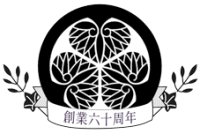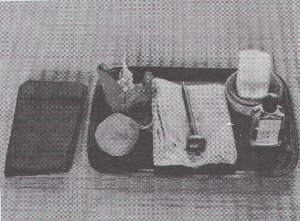How to take care of swords
!
| Manual of How to handle and Take Care of
Swords_1 (an extraction from Nippon Bijutsu Token Hozon Kyokai, The Japanese Sword Museum) |
|||
| Traditionally the Japanese sword has been
a most important treasure of the Japanese
people. We should do what we can preserve
it in order to pay respect to our anscestors
who crreated such a great form of art.
Swords
must be treated with utmost precaution
so
as not to injure the handler. Precautions
to protect them from scratches and
rust are
also necessary. |
|||
| 1. Precautions to be taken in handling the
Nipponto (1) All swords, whether encased in plain wooden scabbards and hilts(Shirasaya) or formal mountings(Koshirae), need to be kept in their swordbags. The head of the scabbard(Kojiri) must go into the bag first to avoid the possibility an acciddental fall. (2) To carry a sword, the scabbard(Saya) must be held with one's right hand. The hilt(Tsuka) must be put up and the blade must hang down. This measure will prevent dangerous acceidents. (3) Whenever one draws a mounted sword out of its bag or scabbard, make sure the position of the hilt does not go lower then the scabbard. (4) The registration card should be either be tied to the scabbard or sewed onto the swordbag. The sword owner in Japan has a legal obligation to keep a sword and its registlation card together. |
3. Method of maintenance The major purpose of swordcare is to make sure the steel surface does not oxidize or rust. Therefore, it is necessary to throughly remove the stale oil and replace it entirely with new oil. The following describes the tools used and the order of operations of swordcare. (A) Tools 1. Mekugi-nuki: A tool to remove the bamboo peg(Mekugi) holding the blade in the hilt; usually made of brass or bamboo. 2. Uchiko: The most finely ground whetstone powder (30-35gram) for cleaning the blade surface. First, wrapped in Japanese hand-made paper called Yoshino-gami, then rewrapped by cotton or silk cloth, it comes through the wrapping materials when patted on the blade surface. 3. Nuguigami: High quality thick Japanese paper must be throughly wrinkled to soften and remove coarse and dusty elements for wiping the blade surface. There are tow reasons for the wiping function; one for preliminary removal of old oil and the other for removal of the powder. When using flannel, the fabric must be washed, destarched in water, then dried. 4. Abura: A rust-preventive oil called Choji or clover oil. 5. Abura-nuguishi: Paper used to spread oil over the blade surface. A piece of wiping paper or flannel will do. 6. Others: A wooden hammer and benzene, if necessary.
|
||
| 2. How to draw a sword out of the scabbard
and put it back (1) Whether drawing out a Tachi or Katana, one must hold the cutting edge up and grasp the scabbard from underneath in the left hand in a forward holding position. Then, hold the hilt from above with the right hand. Since the scabbard is rather tight fit at the opening where the collar(Habaki) is fit(Koikuchi), the initial pull must be very carefully made so that only the collar's length gets drawn out. Giving a sudden powerful pull may not only impair the opening of the scabbard but also result in an uncontrollable jerk leading to injury. Holding the blade still, pull it entirely out of the scabbard very slowly making certain the cutting edge never faces down or sideways. (2)When a blade is placed back in the scabbard,its case must be held by the left hand and the hilt by the right hand as in the pulling-out process. The tip of the sharp edge facing up must first rest gently the opening of the scabbard. Again, holding the blade still, slide the blade along the dich ino the scabbard. When the collar reaches the opening of the case, a firm push is necessary to ensure steady settlement. As before, the cutting edge must not face down or sideways. |
|||
|
|
|||

